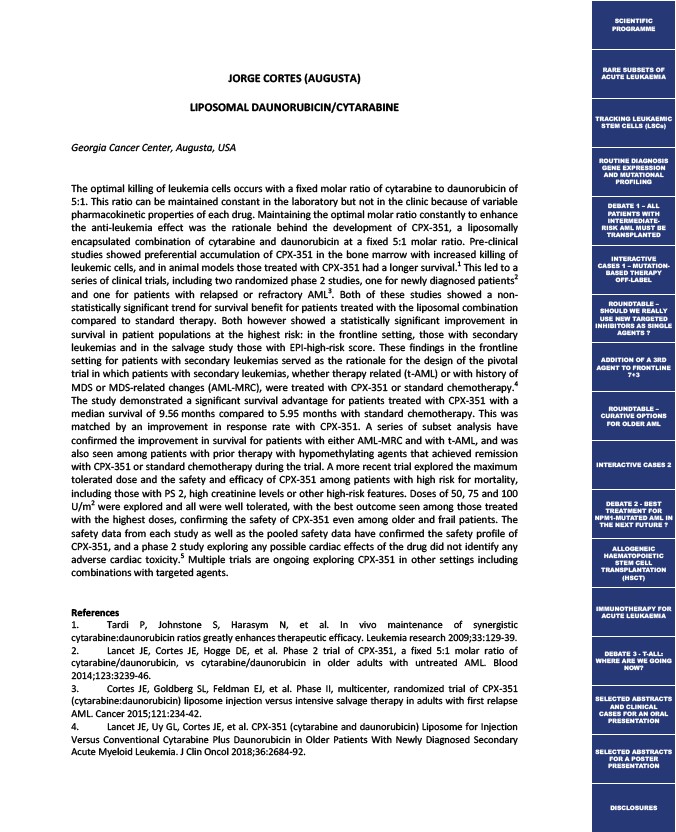
JORGE CORTES (AUGUSTA)
LIPOSOMAL DAUNORUBICIN/CYTARABINE
Georgia Cancer Center, Augusta, USA
The optimal killing of leukemia cells occurs with a fixed molar ratio of cytarabine to daunorubicin of
5:1. This ratio can be maintained constant in the laboratory but not in the clinic because of variable
pharmacokinetic properties of each drug. Maintaining the optimal molar ratio constantly to enhance
the anti-leukemia effect was the rationale behind the development of CPX-351, a liposomally
encapsulated combination of cytarabine and daunorubicin at a fixed 5:1 molar ratio. Pre-clinical
studies showed preferential accumulation of CPX-351 in the bone marrow with increased killing of
leukemic cells, and in animal models those treated with CPX-351 had a longer survival.1 This led to a
series of clinical trials, including two randomized phase 2 studies, one for newly diagnosed patients2
and one for patients with relapsed or refractory AML3. Both of these studies showed a non-statistically
significant trend for survival benefit for patients treated with the liposomal combination
compared to standard therapy. Both however showed a statistically significant improvement in
survival in patient populations at the highest risk: in the frontline setting, those with secondary
leukemias and in the salvage study those with EPI-high-risk score. These findings in the frontline
setting for patients with secondary leukemias served as the rationale for the design of the pivotal
trial in which patients with secondary leukemias, whether therapy related (t-AML) or with history of
MDS or MDS-related changes (AML-MRC), were treated with CPX-351 or standard chemotherapy.4
The study demonstrated a significant survival advantage for patients treated with CPX-351 with a
median survival of 9.56 months compared to 5.95 months with standard chemotherapy. This was
matched by an improvement in response rate with CPX-351. A series of subset analysis have
confirmed the improvement in survival for patients with either AML-MRC and with t-AML, and was
also seen among patients with prior therapy with hypomethylating agents that achieved remission
with CPX-351 or standard chemotherapy during the trial. A more recent trial explored the maximum
tolerated dose and the safety and efficacy of CPX-351 among patients with high risk for mortality,
including those with PS 2, high creatinine levels or other high-risk features. Doses of 50, 75 and 100
U/m2 were explored and all were well tolerated, with the best outcome seen among those treated
with the highest doses, confirming the safety of CPX-351 even among older and frail patients. The
safety data from each study as well as the pooled safety data have confirmed the safety profile of
CPX-351, and a phase 2 study exploring any possible cardiac effects of the drug did not identify any
adverse cardiac toxicity.5 Multiple trials are ongoing exploring CPX-351 in other settings including
combinations with targeted agents.
R
eferences
1. Tardi P, Johnstone S, Harasym N, et al. In vivo maintenance of synergistic
cytarabine:daunorubicin ratios greatly enhances therapeutic efficacy. Leukemia research 2009;33:129-39.
2. Lancet JE, Cortes JE, Hogge DE, et al. Phase 2 trial of CPX-351, a fixed 5:1 molar ratio of
cytarabine/daunorubicin, vs cytarabine/daunorubicin in older adults with untreated AML. Blood
2014;123:3239-46.
3. Cortes JE, Goldberg SL, Feldman EJ, et al. Phase II, multicenter, randomized trial of CPX-351
(cytarabine:daunorubicin) liposome injection versus intensive salvage therapy in adults with first relapse
AML. Cancer 2015;121:234-42.
4. Lancet JE, Uy GL, Cortes JE, et al. CPX-351 (cytarabine and daunorubicin) Liposome for Injection
Versus Conventional Cytarabine Plus Daunorubicin in Older Patients With Newly Diagnosed Secondary
Acute Myeloid Leukemia. J Clin Oncol 2018;36:2684-92.
SCIENTIFIC
PROGRAMME
RARE SUBSETS OF
ACUTE LEUKAEMIA
TRACKING LEUKAEMIC
STEM CELLS (LSCs)
ROUTINE DIAGNOSIS
GENE EXPRESSION
AND MUTATIONAL
PROFILING
DEBATE 1 – ALL
PATIENTS WITH
INTERMEDIATE-RISK
AML MUST BE
TRANSPLANTED
INTERACTIVE
CASES 1 – MUTATION-BASED
THERAPY
OFF-LABEL
ROUNDTABLE –
SHOULD WE REALLY
USE NEW TARGETED
INHIBITORS AS SINGLE
AGENTS ?
ADDITION OF A 3RD
AGENT TO FRONTLINE
7+3
ROUNDTABLE –
CURATIVE OPTIONS
FOR OLDER AML
INTERACTIVE CASES 2
DEBATE 2 - BEST
TREATMENT FOR
NPM1-MUTATED AML IN
THE NEXT FUTURE ?
ALLOGENEIC
HAEMATOPOIETIC
STEM CELL
TRANSPLANTATION
(HSCT)
IMMUNOTHERAPY FOR
ACUTE LEUKAEMIA
DEBATE 3 - T-ALL:
WHERE ARE WE GOING
NOW?
SELECTED ABSTRACTS
AND CLINICAL
CASES FOR AN ORAL
PRESENTATION
SELECTED ABSTRACTS
FOR A POSTER
PRESENTATION
DISCLOSURES